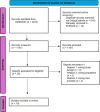Aftercare following fatal traumatic injuries, needs and questions: a level 1 trauma center study and scoping review
- PMID: 40522342
- PMCID: PMC12170696
- DOI: 10.1007/s00068-025-02895-7
Aftercare following fatal traumatic injuries, needs and questions: a level 1 trauma center study and scoping review
Abstract
Purpose: Approximately 2,000 people die each year in the hospital due to accidental or inflicted traumatic injuries in the Netherlands. This has major emotional and socioeconomic consequences. Bereavement support is offered to prevent complicated grief, however, recommendations on adequate aftercare by the hospital are lacking.
Methods: Patients with fatal traumatic injuries admitted to the Northwest Clinics, Alkmaar, or Amsterdam University Medical Center, VUMC, between January 1st 2021, and January 1st 2023, were assessed for eligibility (Injury Severity Score ≥ 16, in-hospital mortality). Their relatives were contacted, and a questionnaire was administered to evaluate their experiences with the aftercare provided by the hospital. In addition, a scoping review was performed to report on recommendations to improve aftercare.
Results: A total of 1,131 articles were identified for the scoping review, of which 10 were selected for analysis (four questionnaires and six interview-based studies). The implementation of grief services by skilled professionals is recommended. The most frequently reported time between death and contact was 4-6 weeks, with contact conducted via telephone. During the study period, 110 patients met the inclusion criteria for the questionnaire. The median age of the deceased was 70 years (SD 20); 58% were male, with a median Injury Severity Score of 26 (range 16-75). Bereavement support was offered to 50% of the relatives, requested by 34%, and absent or lacking for 24%.
Conclusion: Aftercare following traum-related in-hospital deaths remains inconsistent. Both the questionnaire and scoping review recommend structured aftercare. Aftercare, by telephone or face-to-face, conducted by a trained professional four weeks after the death, is suggested to favorably influence the course of bereavement or lead to timely referral for grief counseling.
Keywords: Aftercare; Bereavement support; Grief; Questionnaire; Review; Trauma surgery.
© 2025. The Author(s).
Conflict of interest statement
Declarations. Data access: Research data supporting this publication are available in the Supplementary and upon reasonable request. Competing interests: The authors declare no competing interests.
Figures
Similar articles
-
Surveillance for Violent Deaths - National Violent Death Reporting System, 50 States, the District of Columbia, and Puerto Rico, 2022.MMWR Surveill Summ. 2025 Jun 12;74(5):1-42. doi: 10.15585/mmwr.ss7405a1. MMWR Surveill Summ. 2025. PMID: 40493548 Free PMC article.
-
Follow-up of grieving families in general and family medicine: a cross-sectional study on the practices and attitudes of family doctors.Fam Med Community Health. 2025 Aug 24;13(3):e003296. doi: 10.1136/fmch-2025-003296. Fam Med Community Health. 2025. PMID: 40854614
-
Is level 1 trauma care necessary for all severely injured older patients? Evaluating undertriage and feasibility of care in major and non-major trauma centres in the Netherlands.Eur J Trauma Emerg Surg. 2025 Jun 16;51(1):230. doi: 10.1007/s00068-025-02897-5. Eur J Trauma Emerg Surg. 2025. PMID: 40522477 Free PMC article.
-
Has the documentation of chest injuries and the development of systemic complications in patients with long bone fractures changed over time?-A systematic literature review and meta-analysis by the IMPACT expert group.Injury. 2025 Mar;56(3):112182. doi: 10.1016/j.injury.2025.112182. Epub 2025 Jan 23. Injury. 2025. PMID: 39874866
-
Use of Augmented Reality for Training Assistance in Laparoscopic Surgery: Scoping Literature Review.J Med Internet Res. 2025 Jan 28;27:e58108. doi: 10.2196/58108. J Med Internet Res. 2025. PMID: 39874568 Free PMC article.
References
-
- WHO. Injuries and violence. Accessed on 04-05-2025.
-
- Accidents. and injuries statistics - Statistics Explained (europa.eu).
-
- 231101_rapport_landelijke_traumaregistratie_2018_-. _2022_-_definitief.pdf (lnaz.nl).
-
- Kristensen P, Weisæth L, Heir T. Bereavement and mental health after sudden and violent losses. Rev Psychiatry. 2012;75(1):76–97. - PubMed
-
- Raphael B, Martinek N. Assessing traumatic bereavement and posttraumatic stress disorder. In: Wilson J, Keane T, editors. Assessing psychological trauma and PTSD. NewYork: Guilford Press; 1997. pp. 373–95.
Publication types
MeSH terms
LinkOut - more resources
Full Text Sources
Medical
Miscellaneous



